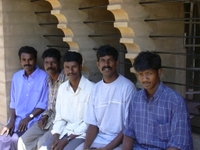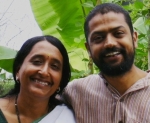In the Year 1988, as fresh graduates with a degree in Architecture, and disillusioned with the formal education system, we moved to the village community of Gandhigram in Tamil Nadu, India. Our disillusionment came about with our active participation as students in the National Campaign for Housing Rights. The campaign brought us in contact with a number of grassroots activist organizations and non-governmental organizations (NGOs). It also gave us a peek into the rural reality, about which we had had no clue before. We realised the severe limitations of the formal educational system and its lack of relevance to problems on the ground. One of us gave up the idea of preparing for higher education abroad and the other discontinued from the Masters course in Architecture midway.
Our work in Gandhigram was a beginning in the long process of re-educating ourselves. We had to learn many skills from scratch (such as masonry!) and learn properties of common but unknown (to us) building materials, such as mud. We also had to motivate and train our own team of construction workers (and train ourselves in the process) to be interested in alternative and environmentally sustainable building technologies. We received a lot of support in learning about alternative technologies from Prof. Jagadish, Dr. Yogananda and the team in ASTRA at IISc, Bangalore.
In Gandigram we also helped set up a women’s group to produce and market items ranging from coir mats to black & white TV sets. This was a formative, crucial phase in our life, when we made friends with like minded people, decided to get married to each other, and to make an attempt at living & working in rural areas.
Our work with alternative building had attracted some attention and other NGOs and a corporate client approached us for help. We made use of this opportunity to spread some of the ideas we were working with, especially the idea of training local artisans (so-called unskilled people) in alternative building technologies. These technologies are based on using local materials and generating local employment. (Of course, local materials does not mean using old technologies – throughout our professional lives mud-based building technologies have been constantly improving and evolving.) We were surprised that even the corporate client – usually used to the idea of contractors from cities coming to build their structures – agreed with our ideas and pursued them for almost 8 years. In the process, they helped us to train several groups of village masons in their area.
In 1993 we moved to Gudalur, a tribal area in the Nilgiris district of Tamil Nadu. Here we worked with the adivasi (indigenous) youth. An NGO called ACCORD was doing very interesting work with the aim of equipping adivasi youth with varying skills to manage the affairs of their own community. The youth were trained to be community organisers, community health workers, nurses, teachers, masons, plantation managers, hospital administrators, and office admin staff. Most of the youth had not finished schooling. Yet the faith reposed in them by the team, and the quality of training provided by committed professionals, produced spectacular results. The outcome was an adivasi group of committed individuals who go about their business with dignity and self-respect and display skill levels that evoke the respect of the local non-tribal community that had previously looked down upon them.
Our involvement in the organization gave us a range of experiences from very skill-specific ones (mason training/working on the rural housing programme) to very general ones such as motivating youth and helping them to grow into self-confident adults. For the latter we did more formalised training sessions to help the mason trainees get basic engineering skills such as drawing and estimation (for which we had to start from basics of multiplication and division).

Masons from Gudalur….

….and the house they built
ACCORD also runs an alternative school, Vidyodaya, which was started for the team’s children and later converted into an adivasi school. From 2001, Anu taught children in this school for two years. During this time we got more interested in children’s education. We also realised that more than designing and putting up buildings, we really enjoyed teaching rural people. Their keen interest in acquiring knowledge, and the satisfaction of providing knowledge and help one learn a skill was something we found very satisfying. We found such interventions more meaningful especially in areas where the quality of education (if any!) was appalling, and where the right education could help a person gain self-confidence and self-respect.
In 2000-2001, we travelled for a year with our children to various projects/schools around India, with the idea of getting exposure to working with children. The highlights were teaching English and Math to the tribal health trainees in the Sittilingi hospital for 3 months, working with the children in the KFI school in Uttarkashi for 5 weeks, and later at the Timbaktu school for 3 months. Our plans had to be modified somewhat due to the earthquake in Bhuj, Gujarat (as Krishna was there on the day of the quake conducting a workshop on stabilised mud block making). The second half of our year was spent mostly in Kutch working on the rehabilitation of the earthquake-affected people.
After all these experiences we feel:
- That children from disadvantaged sections in the rural areas need an education that would help them gain self respect and help live with dignity. For this they need to acquire skills relevant to the community and the local economy.
- That children have a natural curiosity and capacity to learn that needs to be nurtured, giving them space and the right environment.
- That children need the company of sympathetic adults who can encourage/ motivate them to acquire skills and knowledge.
Regi and Lalitha, who were working with us in Gandhigram as doctors, had moved to Sittilingi in 1993 and had set up a community-based health programme. We had been making several visits through the years to help design and construct their buildings, and also interacted with their team doing training sessions. We have seen the place and the team grow and heard from them the need for a meaningful intervention in education. So we moved to Sittilingi in June 2003.
***********
